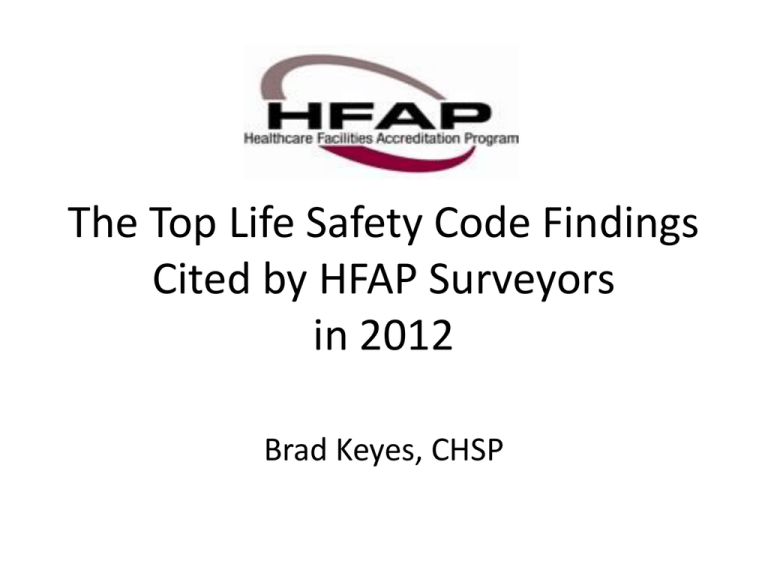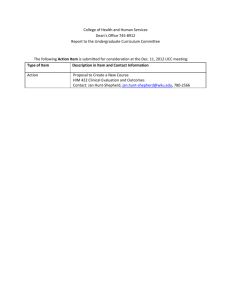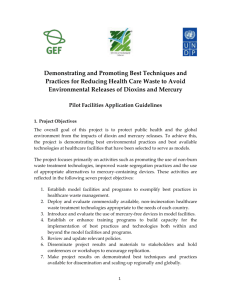The Top Life Safety Code Findings Cited by HFAP Surveyors
advertisement

The Top Life Safety Code Findings Cited by HFAP Surveyors in 2012 Brad Keyes, CHSP The New 2012 Life Safety Code The Centers for Medicare & Medicaid Services (CMS) announced in late 2011 that they are reviewing the 2012 edition of the Life Safety Code for adoption The last time they upgraded, they went from the 1985 edition to the 2000 edition, on March 11, 2003 Healthcare Facilities Accreditation Program 2 The New 2012 Life Safety Code Accreditation organizations (such as HFAP) are required to survey hospitals for compliance with the 2000 edition, and cannot move to the more recent edition until CMS adopts it Last time, it took CMS, 3 years to adopt the 2000 edition after they said they were ‘reviewing’ it, so look for this to become final in 2014 or 2015 Healthcare Facilities Accreditation Program 3 The New 2012 Life Safety Code There are significant changes in store for hospitals and ASC when the 2012 edition is finally adopted HFAP will address those changes in future webcasts Healthcare Facilities Accreditation Program 4 The Top Five LSC Findings During 2012, HFAP surveyors identified the following issues for opportunities for improvement in regards to life safety compliance: 1. 2. 3. 4. 5. Corridor clutter Rated wall penetrations Fire alarm records Doors ALSM implementation Healthcare Facilities Accreditation Program 5 Corridor Clutter Corridors must remain free of unattended items for the required width of the corridor Exception! Crash carts and isolation supply carts are excluded, as long as the carts are mounted on wheels, and staff has been trained to relocate the carts during a fire alarm Healthcare Facilities Accreditation Program 6 Corridor Clutter Isolation supply carts are only permitted as long as they are outside a patient’s room that is currently on contact precautions (Signs must be posted) This does allow unattended items to be staged in corridors for up to 30 minutes before it becomes a deficiency Healthcare Facilities Accreditation Program 7 Corridor Clutter Scenes like this will lead to surveyor findings during a survey Healthcare Facilities Accreditation Program 8 Corridor Clutter ‘Attended’ means an item is actively in use and attended by a person, who must be located on the unit This may include housekeeping carts, foodservice carts, maintenance carts, linen and trash carts, computers on wheels… Any item that has a person assigned to it and the cart is accessed at least every 30 minutes Healthcare Facilities Accreditation Program 9 Corridor Clutter However… Once the cart is no longer attended, then it must be relocated to an appropriate storage space Healthcare Facilities Accreditation Program 10 Corridor Clutter The required width of the corridor is up to 8 feet wide New construction requires 8 foot wide corridors, but existing may allow less Nothing may be located in the corridor that obstructs the required width (up to 8 feet) Healthcare Facilities Accreditation Program 11 Corridor Clutter However, if the corridor is wider than 8 feet, then you are permitted to store noncombustible items as long as they do not obstruct the required width of the corridor (up to 8 feet) Healthcare Facilities Accreditation Program 12 Rated Wall Penetrations The integrity of fire rated barriers and smoke compartment barriers must remain intact in order to prevent the transfer of smoke during a fire All wires, cables, pipes, conduits and ducts that penetrate rated barriers must be properly sealed Healthcare Facilities Accreditation Program 13 Rated Wall Penetrations Penetrations must be sealed by approved fire rated materials (i.e. fire caulk) and methods to ensure smoke-tight enclosures Healthcare Facilities Accreditation Program 14 Rated Wall Penetrations Healthcare Facilities Accreditation Program 15 Rated Wall Penetrations Even repairs and patching of holes in rated walls must be done correctly, and in accordance with UL or FM Global listings Healthcare Facilities Accreditation Program 16 Life Safety Test Records Fire alarm systems must be tested in accordance with NFPA 72 (1999 edition) Frequent deficiencies with fire alarm test reports: 1. Test report does not list every device in the fire alarm system, its location, and whether it passed or failed its test Healthcare Facilities Accreditation Program 17 Life Safety Test Records Deficiencies with fire alarm test reports: 2. Not all devices are tested • • • • • • Smoke, heat and duct detectors Pull stations Strobes, horns and bells Control panels Batteries Interface devices Healthcare Facilities Accreditation Program 18 Life Safety Test Records Interface devices are relays and control modules that connect the fire alarm system to other devices, such as: – – – – – – – Magnetic locks Magnetic hold-opens Air handler shut-down Smoke dampers Fire pump Elevator recall Other fire suppression systems Healthcare Facilities Accreditation Program 19 Life Safety Test Records Deficiencies with fire alarm test reports: 3. Batteries in all control panels and NAC panels are not tested properly: • • • Charger test Discharge test Load voltage test (annually) (annually) (semi-annual) Healthcare Facilities Accreditation Program 20 Life Safety Test Records Deficiencies with fire alarm test reports: 4. Fire alarm technicians (whether they are your employees or a contractor’s) are not properly certified, licensed or work for an approved fire alarm contractor Healthcare Facilities Accreditation Program 21 Life Safety Test Records Deficiencies with sprinkler test reports: 1. Annual inspection is not conducted 2. Main drain tests are not conducted at system risers 3. Annual control valve exercise is not performed 4. 5-year standpipe water-flow test not performed 5. Fire pump annual flow test is not performed under emergency power Healthcare Facilities Accreditation Program 22 Life Safety Test Records Deficiencies with emergency power generator test reports: 1. Monthly load tests conducted outside of the 20 day / 40 day window 2. Not all Automatic Transfer Switches (ATS) are tested each month 3. Annual load test not performed when a monthly load test fails to meet 30% of the nameplate capacity Healthcare Facilities Accreditation Program 23 Doors Some doors are fire rated doors, while other doors are non-rated, but they all must resist the passage of smoke and close properly Frequent deficiencies with doors: 1. Corridor doors (non-rated) do not close and latch properly Healthcare Facilities Accreditation Program 24 Doors Corridor doors cannot be propped open with wedges or stops Healthcare Facilities Accreditation Program 25 Doors Corridor doors cannot have roller latches Healthcare Facilities Accreditation Program 26 Doors Damaged fire rated doors must be replaced Healthcare Facilities Accreditation Program 27 Doors Labels on fire rated doors are not legible Healthcare Facilities Accreditation Program 28 Alternative Life Safety Measures Alternative Life Safety Measures (ALSM) are also known as Interim Life Safety Measures, must be implemented to compensate for a life safety deficiency If part of the sprinkler system or fire alarm system is impaired, then ALSM must be implemented, such as a fire watch Healthcare Facilities Accreditation Program 29 Alternative Life Safety Measures Other life safety impairments that would requires ALSM: – Partial or total obstruction of an exit access corridor – Closing an exit stairwell for maintenance – Unsealed penetrations discovered in rated barriers – Defective fire or smoke damper – A fire alarm device that failed its test Healthcare Facilities Accreditation Program 30 Alternative Life Safety Measures Other life safety impairments that would requires ALSM: – Non-functioning fire pump – Sprinkler control valve that is not electronically supervised – Generator that failed its monthly load test – Battery powered emergency lights with dead batteries Healthcare Facilities Accreditation Program 31 Alternative Life Safety Measures Possible measures to consider for implementation: – Staff education: Notify staff in area where impairment is located of deficient life safety – Staff education: Special training for staff affected by impairment – Daily inspections: Perform daily rounds of impaired area Healthcare Facilities Accreditation Program 32 Alternative Life Safety Measures Possible measures to consider for implementation: – Signage: Post signs identifying alternative exits – Additional fire fighting equipment: Provide extra fire extinguishers for area with impairment – Temporary construction barriers: Provide temporary non-combustible, smoke-tight fire barriers in impaired area Healthcare Facilities Accreditation Program 33 Alternative Life Safety Measures Possible measures to consider for implementation: – Debris removal: Enforce general housekeeping practice by removing all debris daily from impaired area – Extra fire drill: Conduct an extra fire drill per shift per quarter in the affected area Healthcare Facilities Accreditation Program 34 Alternative Life Safety Measures All life safety deficiencies must be assessed for ALSM if the deficiency cannot be resolved the same day it is discovered Once ALSM activity begins, it must continue until the life safety deficiency is resolved Healthcare Facilities Accreditation Program 35 The Top Life Safety Code Findings Cited by HFAP Surveyors in 2012 Questions? Brad Keyes, CHSP bkeyes@hfap.org (815) 742-4367







